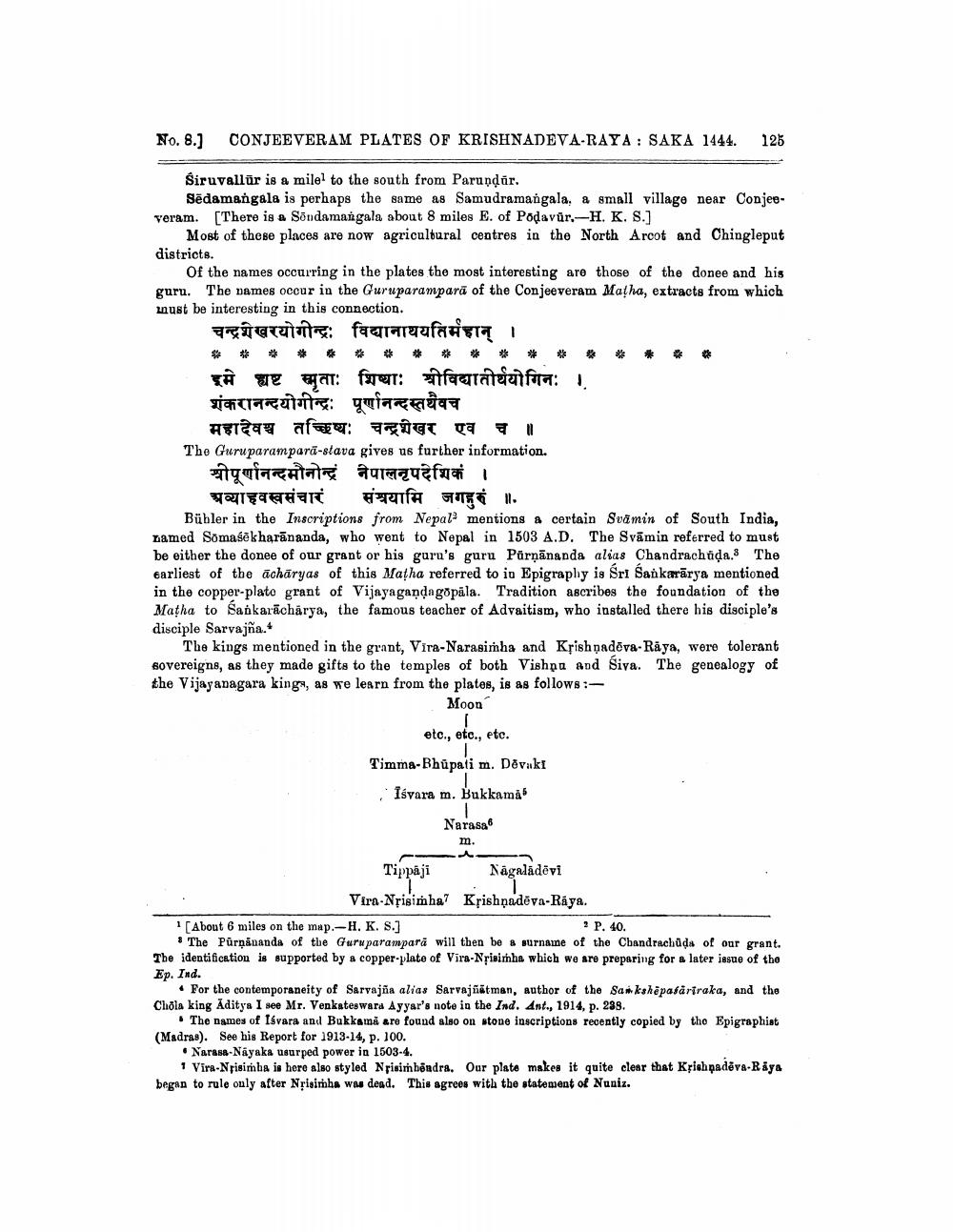________________
No. 8.]
CONJEEVERAM PLATES OF KRISHNADEVA-RAYA: SAKA 1444. 125
Siruvallur is a milel to the south from Paruṇḍār.
Sēdamangala is perhaps the same as Samudramangala, a small village near Conjeeveram. [There is a Sendamangala about 8 miles E. of Pōdavur.-H. K. S.]
Most of these places are now agricultural centres in the North Arcot and Chingleput districts.
Of the names occurring in the plates the most interesting are those of the donee and his guru. The names occur in the Guruparampara of the Conjeeveram Matha, extracts from which nust be interesting in this connection.
चन्द्रशेखरयोगीन्द्रः विद्यानाथयतिर्महान् ।
$ * * * # * 弥絲 # * * *
इमेट मृताः शिवाः श्रीविद्यातीर्घयोगिनः । शंकरानन्दयोगीन्द्रः पूर्णानन्दस्तथैवच
महादेवच तच्छिष्णः चन्द्रशेखर एव च ॥
The Guruparampara-stava gives us further information. श्रीपूर्णानन्दमोनोन्द्र नेपालनृपदेशिकं ।
अव्याहवस्वसंचारं संचयामि जगदुदं ॥
Bühler in the Inscriptions from Nepal mentions a certain Svamin of South India, named Somasekharananda, who went to Nepal in 1503 A.D. The Svamin referred to must be either the donee of our grant or his guru's guru Pürṇānanda alias Chandrachuḍa. The earliest of the acharyas of this Matha referred to in Epigraphy is Sri Sankararya mentioned in the copper-plate grant of Vijayaganḍagopala. Tradition ascribes the foundation of the Matha to Sankaracharya, the famous teacher of Advaitism, who installed there his disciple's disciple Sarvajña.*
The kings mentioned in the grant, Vira-Narasimha and Krishnadeva-Raya, were tolerant sovereigns, as they made gifts to the temples of both Vishnu and Śiva. The genealogy of the Vijayanagara kings, as we learn from the plates, is as follows:
Moon [ etc., etc., etc. T Timma-Bhupati m. Děvaki
I Isvara m. Bukkamā
I
Narasa6
m.
Tippaji
Vira Nrisimha
Nagali Nāgalādēvi Krishnadeva-Raya.
[About 6 miles on the map.-H. K. S.]
2 P. 40.
The Pūrṇānanda of the Guruparampara will then be a surname of the Chandrachuḍa of our grant. The identification is supported by a copper-plate of Vira-Nrisimha which we are preparing for a later issue of the Ep. Ind.
For the contemporaneity of Sarvajña alias Sarvajätman, author of the Samkshepasäriraka, and the Chola king Aditya I see Mr. Venkateswara Ayyar's note in the Ind. Ant., 1914, p. 238.
The names of Isvara and Bukkama are found also on stone inscriptions recently copied by the Epigraphist (Madras). See his Report for 1913-14, p. 100.
Narasa-Nayaka usurped power in 1503-4.
Vira-Nrisimha is here also styled Nrisimhendra. Our plate makes it quite clear that Krishnadeva-Raya began to rule only after Nrisimha was dead. This agrees with the statement of Nuniz.




